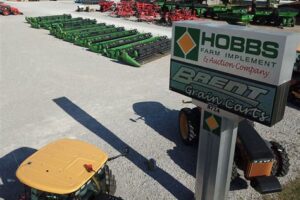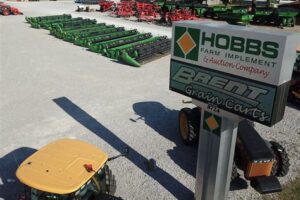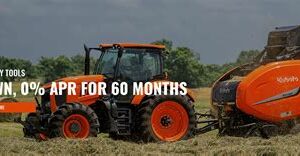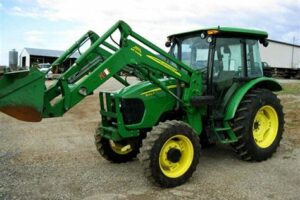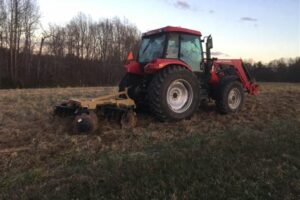Table of Contents
Depreciation for farm equipment is a crucial aspect of managing agricultural operations. This article explores the concept of depreciation, its significance in the farming industry, and how it affects the financial health of farmers. Discover how to calculate depreciation for different types of farm equipment and gain insights into strategies for minimizing depreciation expenses. Stay informed about this important aspect of farm management to make informed decisions and optimize your agricultural investments.
Depreciation for farm equipment is a crucial aspect that every farmer should have a firm grasp of. As the backbone of agricultural operations, farm equipment plays an indispensable role in ensuring the productivity and profitability of farming endeavors. However, the value of this equipment gradually diminishes over time due to wear and tear, technological advancements, and market fluctuations. Understanding the concept of depreciation is essential for farmers to make informed decisions regarding equipment purchases, budgeting, and overall financial planning. In this article, we will delve into the intricacies of depreciation for farm equipment, exploring its implications and providing valuable insights on how farmers can effectively manage this inevitable phenomenon.
Introduction
Depreciation is an essential concept in the world of farm equipment. It refers to the decline in value over time due to wear and tear, obsolescence, or other factors. Understanding depreciation is crucial for farmers and agricultural businesses as it directly affects their financial statements and tax liabilities. This article will delve into the topic of depreciation for farm equipment, exploring its importance, calculation methods, and implications.
What is Depreciation?
Depreciation is a systematic allocation of the cost of an asset over its useful life. In the case of farm equipment, depreciation represents the reduction in value that occurs as a result of usage, age, market conditions, or technological advancements. By recognizing this decrease in value over time, farmers can account for the cost of their equipment and plan for replacements or upgrades in the future.
Methods of Depreciation
There are several methods used to calculate depreciation for farm equipment:
Straight-Line Depreciation
The straight-line method is the most commonly used depreciation method. It evenly allocates the cost of an asset over its useful life. To calculate depreciation using this method, you divide the initial cost of the equipment by its estimated useful life. For example, if a tractor costs $100,000 and is expected to last 10 years, the annual depreciation expense would be $10,000 ($100,000 divided by 10).
Declining Balance Depreciation
The declining balance method is another commonly used approach. This method assumes that the asset depreciates more in its earlier years and less in its later years. The most common variation of this method is the double-declining balance, which doubles the straight-line rate. For example, if the straight-line depreciation rate is 10%, the double-declining rate would be 20%. However, this method cannot be used indefinitely and should be stopped once the straight-line method becomes more beneficial.
Units of Production Depreciation
The units of production method ties depreciation to the usage or production of an asset. Instead of basing depreciation on time, it considers the equipment’s output or hours of use. This method is particularly useful for farm equipment since different machines may have varying levels of usage throughout the year. By allocating depreciation based on actual usage, farmers can more accurately account for the cost of their equipment.
Factors Affecting Depreciation
Several factors influence the depreciation of farm equipment:
Usage and Maintenance
The more an equipment is used and the less it is maintained, the faster it will depreciate. Proper maintenance, regular servicing, and adherence to manufacturer guidelines can help slow down depreciation and extend the useful life of the equipment.
Market Conditions
Fluctuations in the market can affect the value of farm equipment. Changes in supply and demand, advancements in technology, or shifts in industry preferences can impact the resale value of equipment. It is important to consider these market conditions when estimating depreciation and planning for equipment replacement.
Obsolescence
Technological advancements can quickly render farm equipment obsolete. Newer models may offer improved efficiency, functionality, or safety features, making older equipment less desirable. The rate of obsolescence should be factored into depreciation calculations to ensure accurate financial reporting.
Implications of Depreciation
Understanding the implications of depreciation for farm equipment is essential for financial planning and decision-making:
Financial Statements
Depreciation directly affects the balance sheet and income statement of a farm business. As equipment depreciates, its value is reduced on the balance sheet, impacting the overall net worth of the business. Additionally, depreciation expenses are deducted from revenue on the income statement, reducing taxable income.
Tax Deductions
Depreciation allows farmers to deduct the cost of equipment over its useful life, reducing their tax liabilities. By properly calculating and documenting depreciation expenses, farmers can lower their taxable income and potentially qualify for additional tax deductions or credits.
Conclusion
Depreciation is a vital concept for farmers and agricultural businesses to understand. By accurately calculating and accounting for the decline in value of farm equipment, farmers can make informed financial decisions, plan for replacements, and optimize their tax liabilities. Considering factors such as usage, maintenance, market conditions, and obsolescence, farmers can effectively manage their equipment assets and ensure the long-term success of their operations.
Importance of Depreciation in Farming Operations:
Depreciation plays a crucial role in farming operations as it enables farmers to accurately track the decline in value of their machinery and equipment over time. By recognizing this decrease in value, farmers can estimate the costs associated with the wear and tear on their equipment and adjust their budgets accordingly. Properly accounting for depreciation also aids in assessing the profitability of farming activities and making informed decisions about equipment replacement or upgrades.
Methods of Calculating Depreciation:
Farmers can choose from various methods to calculate depreciation, such as the straight-line method, declining balance method, or units of production method. The straight-line method divides the total cost of the equipment by its useful life to determine the annual depreciation expense. The declining balance method applies a constant depreciation rate to the decreasing book value of the equipment, while the units of production method assigns depreciation based on the equipment’s usage or productivity.
Factors Affecting Depreciation:
Several factors influence the amount of depreciation experienced by farm equipment. The age of the equipment, hours of usage, maintenance practices, and market demand for newer technology all impact the depreciation value. Additionally, natural elements such as weather conditions and the type of farming operation can also affect the wear and tear on machinery, potentially accelerating depreciation rates.
Role of Book Value in Depreciation:
Book value represents the original cost of the equipment less accumulated depreciation. It provides insight into the current value of the machinery and aids in determining its future depreciation. Continually updating the book value allows farmers to monitor the true value of their equipment and make informed decisions about repairs, replacements, or selling assets.
Tax Implications of Depreciation:
Depreciation expenses can have significant tax benefits for farmers. Some countries allow farmers to deduct depreciation expenses from their taxable income, reducing the amount of tax they owe. However, tax regulations can vary, so it is prudent for farmers to consult with tax professionals experienced in agricultural accounting to ensure compliance with all relevant tax laws and regulations.
Depreciation in Financial Statements:
Farmers need to accurately reflect the depreciation expense on their financial statements to provide a clear picture of their asset values and profitability. Compliance with accounting standards ensures the transparency and accuracy of financial statements, which is important for internal management, potential investors, lenders, and other stakeholders in the farming business.
Planned Equipment Replacement:
By accurately analyzing depreciation trends, farmers can predict the optimal time for equipment replacement. Understanding the depreciation rate of machinery enables farmers to plan for and budget the costs associated with purchasing new equipment. Planning ahead allows farmers to avoid unexpected breakdowns or inefficient equipment, minimizing operational disruptions and maximizing productivity.
Factors Influencing Equipment Value:
The value of farm equipment is influenced not only by depreciation but also by market factors such as demand and supply, technological advancements, and changing industry standards. Staying informed about market trends and conducting regular equipment appraisals can help farmers gauge the true value of their machinery and make informed decisions about equipment upgrades, trade-ins, or sales.
Depreciation for farm equipment is an essential aspect to consider for farmers and agricultural businesses. It refers to the decrease in the value of equipment over time due to factors such as wear and tear, obsolescence, or market fluctuations. Understanding and properly managing depreciation is crucial for financial planning and decision-making in the farming industry.
There are several key points to consider when discussing depreciation for farm equipment:
- Asset longevity: Farm equipment, such as tractors, harvesters, and irrigation systems, are subject to heavy use and exposure to harsh environmental conditions. As a result, their lifespan may be limited compared to other types of equipment. Recognizing the expected longevity of each asset is crucial for accurate depreciation calculations.
- Residual value: When calculating depreciation, it is important to estimate the residual value of the equipment at the end of its useful life. This residual value represents the estimated worth of the equipment after accounting for depreciation. Accurately determining the residual value allows farmers to plan for future equipment replacement or trade-in options.
- Depreciation methods: There are different depreciation methods available, such as straight-line depreciation, declining balance depreciation, or units of production depreciation. Each method has its own advantages and considerations. Farmers should consult with accounting professionals to determine the most appropriate method for their specific circumstances.
- Tax implications: Depreciation plays a significant role in tax planning for farmers. It allows them to deduct a portion of the equipment’s value from their taxable income each year, reducing their overall tax liability. Farmers should stay updated on tax regulations and consult with tax advisors to maximize the benefits of depreciation and ensure compliance with applicable laws.
- Replacement and upgrade decisions: Understanding the depreciation of farm equipment is crucial for making informed decisions regarding equipment replacement or upgrades. By accurately tracking depreciation, farmers can determine the optimal time to replace aging equipment with newer, more efficient models. This helps maximize productivity, minimize downtime, and improve overall operational efficiency.
- Financial planning and budgeting: Depreciation also plays a vital role in financial planning and budgeting for agricultural businesses. It allows farmers to allocate funds for future equipment purchases, repairs, or upgrades. Accurate depreciation calculations provide a realistic picture of the farm’s asset value and enable better financial forecasting.
In conclusion, depreciation for farm equipment is an important concept that farmers and agricultural businesses must understand and manage effectively. By considering factors such as asset longevity, residual value, depreciation methods, tax implications, replacement decisions, and financial planning, farmers can make informed choices to optimize their equipment investments and ensure long-term success in the farming industry.
Thank you for taking the time to read our comprehensive article on depreciation for farm equipment. We hope that you have found the information provided both informative and useful in understanding the concept of depreciation and its implications for your farming operations. As a professional in the industry, it is essential to be well-versed in the financial aspects of running a farm, including the impact of depreciation on your equipment.
Throughout this article, we have discussed various key points related to depreciation for farm equipment. Firstly, we emphasized the importance of understanding what depreciation is and how it affects the value of your machinery over time. We explained the different methods used to calculate depreciation, such as the straight-line method, declining balance method, and units of production method. By providing examples and explanations, we aimed to simplify these concepts and make them more accessible to our readers.
Furthermore, we discussed the factors that influence the rate of depreciation for farm equipment. These include physical wear and tear, technological advancements, market conditions, and the overall condition and maintenance of the machinery. It is crucial for farmers to regularly assess the condition of their equipment and consider the optimal times for replacement or upgrading to ensure efficient operations and minimize financial losses due to depreciation.
In conclusion, understanding depreciation for farm equipment is essential for effective financial management within the agricultural sector. By considering the various methods of calculating depreciation and the factors influencing its rate, farmers can make well-informed decisions regarding their machinery investments. Regular monitoring of equipment condition and maintenance can help mitigate the effects of depreciation and ensure the long-term sustainability and profitability of farming operations.
We hope that this article has provided you with valuable insights into the world of depreciation for farm equipment. If you have any further questions or would like to explore this topic in greater detail, please feel free to reach out to us. Thank you once again for visiting our blog, and we look forward to continuing to provide you with valuable information to support your farming endeavors.
Video Depreciation For Farm Equipment
1. What is depreciation for farm equipment?
Depreciation for farm equipment refers to the reduction in value that occurs over time due to wear and tear, obsolescence, or other factors. It is a way to account for the decrease in worth of agricultural machinery and tools as they are used in farming operations.
2. Why is it important to consider depreciation for farm equipment?
Considering depreciation for farm equipment is crucial for accurate financial reporting and decision-making. It allows farmers to track the actual value of their equipment, determine the cost of production accurately, and make informed decisions regarding repair, replacement, or resale.
3. How is depreciation calculated for farm equipment?
Depreciation for farm equipment can be calculated using various methods. The most common method is the straight-line depreciation method, where the cost of the equipment is divided by its useful life to determine the annual depreciation expense. Other methods include declining balance and units of production.
4. What factors affect the depreciation of farm equipment?
Several factors can influence the depreciation of farm equipment, including:
- Age: Older equipment generally depreciates at a higher rate.
- Usage: Frequent and heavy use can lead to accelerated depreciation.
- Maintenance: Proper maintenance can help slow down depreciation.
- Technological advancements: Advancements in technology may render older equipment less valuable.
- Market demand: Changes in market demand for certain types of equipment can affect their depreciation rates.
5. Can I claim depreciation for farm equipment on my taxes?
Yes, farmers can typically claim depreciation for farm equipment as a deductible expense on their tax returns. However, specific guidelines and regulations may vary depending on the country or region. It is advised to consult with a tax professional or accountant for accurate information regarding tax deductions for farm equipment depreciation.

